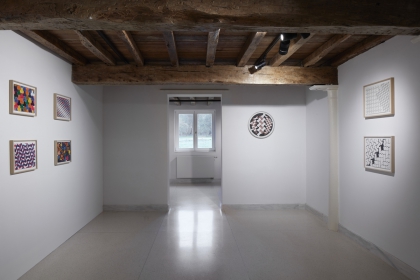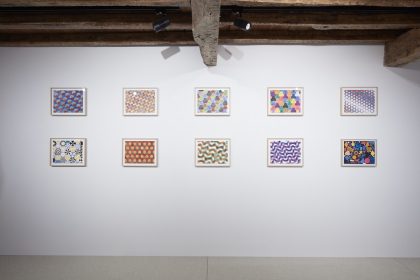
Excursions
Greet Van Autgaerden (b. 1974) lives and works in Mechelen. In her most recent work, she investigates certain crucial aspects of the landscape. On the one hand, she looks at this from a geological and territorial point of view, but on the other, and just as importantly, as a collection of purely physical and formal qualities. Her personal experiences and observations form the basis of her thinking about the landscape and guide her choices within the medium of painting.
The works in the series ‘Excursions’ are born of the tension between the physical space in which one finds oneself and the mental place where one would ultimately like to be. This is a universal idea but also extremely topical, especially at a time when countless people are leaving their familiar surroundings to settle in unknown lands. Greet Van Autgaerden previously explored this theme in the context of ‘Gone West’ (2014), a project to commemorate the First World War. For this exhibition, the artist shut herself inside a bunker at Raversijde. Working in complete darkness, she made a series of drawings depicting the vegetation around the domain or the plants surrounding her Mechelen studio. Using transparencies, these images were brought together in an installation that represented the mental image of both locations, simultaneously. The artist took the visual material for the exhibition ‘Excursions’ from her walks through Belgian countryside, interspersing it with fragments observed while painting or drawn from the rural views beyond the studio, while also intermingling aspects that refer to mental walks in other places, but for which the Flemish landscape acts as a surrogate.
The paintings in the series can be viewed as depictions of the thoughts, or memories, associated with one of these excursions. They unfold in time, can cover multiple visits to the same place, and might span several seasons as a result. The idea behind this excursion is compacted: countless impressions are condensed into a single all-encompassing image. The painting process consists of searching for that one impression, wherein all the individual elements that were important to that place and day – such as light, temperature, sound, atmosphere, details – glide over each other like grids. In the paintings, time and space are stacked, fragmented, rearranged and brought together again. The perspectives are shifted and tilted, or vice versa. Fractures or empty spaces lead the viewer out of one image and into another.
An absence of landmarks creates a form of disorientation and leads to abstraction. The landscape is depersonalised and comes close to a sublime experience of nature. Viewers are invited to decipher and unravel the different layers and, in so doing, to retrace the walk. Beginning with the abstraction, they embark on an excursion through the painterly landscape.













